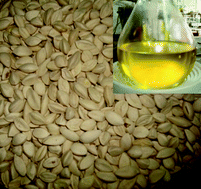Moringa stenopetala seed oil was evaluated as a potential sustainable feedstock for biodiesel production in Ethiopia. Base catalyzed transesterification of M. stenopetala seed oil was carried out with methanol, ethanol and a mixture of methanol and ethanol (1:1 molar ratios) with an alcohol to oil molar ratio of 6:1. The physiochemical characteristics of the esters were assessed to evaluate their suitability for use in standard diesel engines. The study indicated that M. stenopetala seeds yield 45% w/w of oil. The oil contains 78% mono-unsaturated fatty acid and 22% saturated fatty acid. Oleic is the dominant fatty acid, about 76%. When mixtures of alcohols were used, the amount of ethyl ester formed was 30% that of methyl ester. The physicochemical properties of M. stenopetala oil methyl ester and mixture of esters (methyl and ethyl) were found to comply with both the American ASTM D6751 and the European standard EN 14214. Overall, the physicochemical properties of the ester mixture of M. stenopetala oil were better than that of methyl ester. The recommended way to use the oil as a fuel is as a mixture of esters. The study indicates that compared to biodiesel fuels derived from other vegetable oils, M. stenopetala has a number of advantages. Furthermore, the use of M. stenopetala seed oil for the production of biodiesel will not compete with food as neither the seeds nor the oil are used for food in Ethiopia.

You have access to this article
 Please wait while we load your content...
Something went wrong. Try again?
Please wait while we load your content...
Something went wrong. Try again?


 Please wait while we load your content...
Please wait while we load your content...